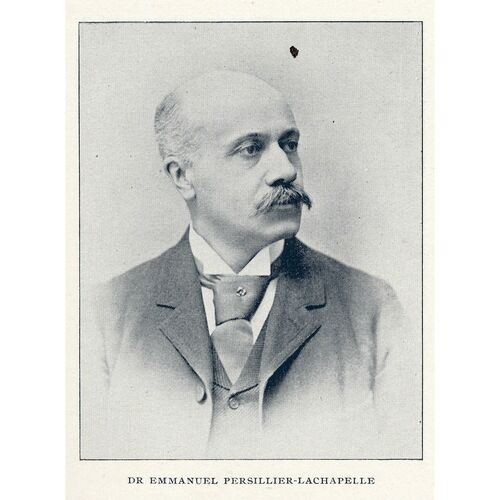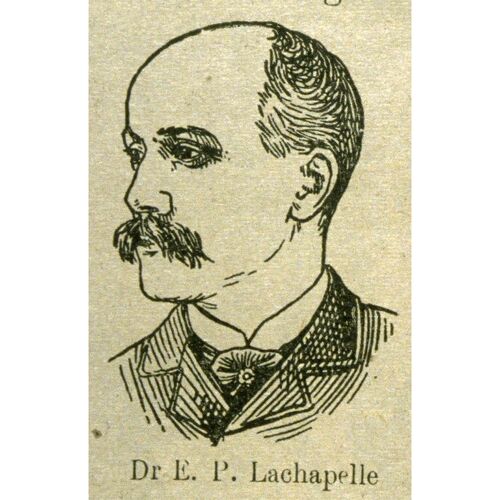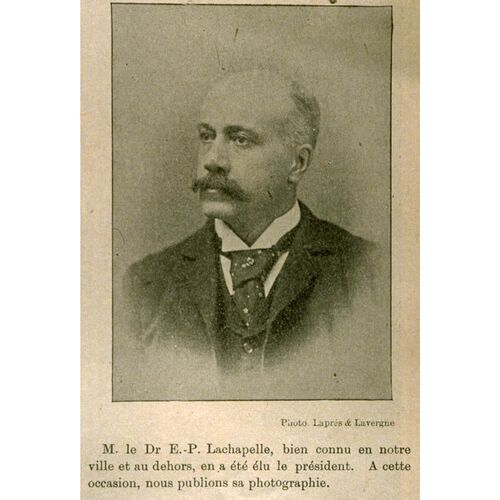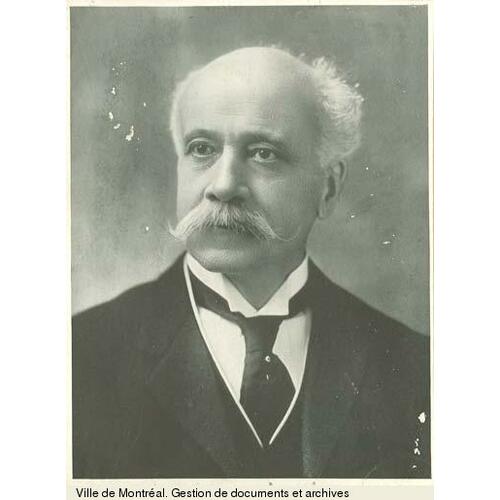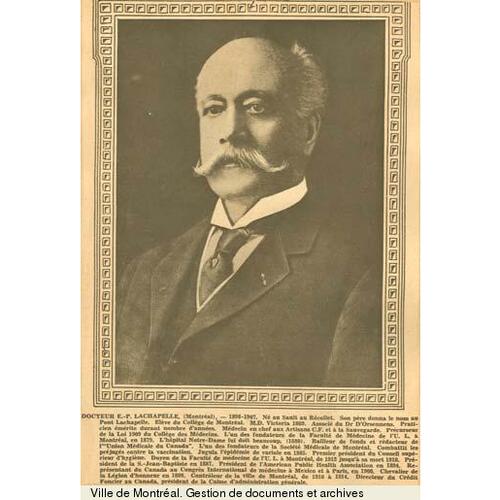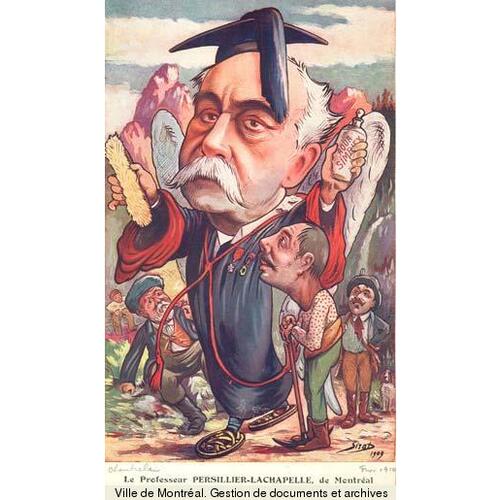LACHAPELLE, EMMANUEL-PERSILLIER (baptized Marie-François-Pierre-Emmanuel), physician, editor, professor, educational administrator, and hospital administrator; b. 21 Dec. 1845 in Sault-au-Récollet (Montreal North), son of Pierre Persillier, dit Lachapelle, a merchant, “country gentleman,” and mayor, and Zoé Toupin; d. unmarried 1 Aug. 1918 in Rochester, Minn., and was buried 6 August in Montreal.
Emmanuel-Persillier Lachapelle’s family came from old French Canadian stock: Étienne Persillier, dit Lachapelle, a native of the Périgord region in France, had settled in New France by 1685. From 1857 to 1865 young Emmanuel-Persillier received a classical education at the Petit Séminaire de Montréal, which his father had attended in 1828–29. He then studied at the Montreal School of Medicine and Surgery, which was affiliated to Victoria College in Cobourg, Ont. After graduating in 1869, he entered the Hôtel-Dieu in Montreal and became a partner in the private practice of Professor Thomas-Edmond d’Odet* d’Orsonnens, who would be the school’s president from 1880 to 1887. In 1871 he was one of the group of physicians who set up the Société Médicale de Montréal. He also helped found L’Union médicale du Canada, a journal established mainly through the initiative of Dr Jean-Philippe Rottot* and first issued in January 1872. Lachapelle would be its editor in 1876–77, and from 1878 to 1882 he and his colleagues Séverin Lachapelle and Adolphe Lamarche would make up the editorial board. It was also in 1872 that he was appointed physician to the 65th Battalion of Rifles (Mount Royal Rifles), a post he held until 1886, although he did not take part in the campaign to put down the Métis rebellion of 1885 in the Canadian northwest. Louis Riel* had been one of his fellow-students at the Petit Séminaire de Montréal, and Lachapelle had supported him in the federal by-election of September 1874 in the Manitoba riding of Provencher. Two years later, as a physician, he had certified Riel as insane.
Lachapelle joined the faculty of the Montreal School of Medicine and Surgery in September 1876, and played a very active part in the dispute that had begun in February between the Université Laval and the school concerning the establishment of a faculty of medicine in Montreal. In 1878 he decided, as Rottot already had, to give his energies to the new Montreal campus of the Université Laval; he remained there when an agreement between the school and the university was broken the following year [see Thomas-Edmond d’Odet d’Orsonnens]. From 1878 to 1889 he was one of the faculty’s two secretaries. A full professor, he taught general pathology, and from 1879–80 physiology. In 1888–89 he was assigned responsibility for forensic medicine, and he also agreed to teach comparative pathology at the École Vétérinaire Française de Montréal, an institution founded in 1886 [see Victor-Théodule Daubigny*] which was affiliated to the Université Laval. The university dispute ended in 1891 and the two parties joined to form a new faculty of medicine at the Université Laval in Montreal, of which Lachapelle would be dean from 1908 until his death.
Lachapelle’s administrative skills and his position as secretary of the faculty had made him the key figure in the creation of Notre-Dame Hospital in Montreal in 1880. Through his many connections in the French Canadian middle-class business community and in clerical circles he won support and obtained substantial assistance for founding this institution and ensuring its operation. He would remain its guiding spirit throughout his life. He was superintendent from 1885 to 1905, chair of the medical board from 1890 to 1917, chair of the medical council from 1907 to 1917, and chair of the board of governors from 1913 to 1917. To a large extent the hospital met the faculty’s need for a place to provide its students with clinical training, a statute in 1847 having stipulated every medical school have access to a clinical facility in a hospital of at least 50 beds, and the new campus being without an affiliated hospital. Housed in the former Donegana’s Hotel on Rue Notre-Dame, it opened on 27 July and could accommodate about 50 patients. The professors directed the medical services, while the Sisters of Charity of the Hôpital Général de Montréal provided nursing care and looked after the internal organization and management. As secretary, Lachapelle was responsible for organizing the hospital in the first months. Not surprisingly, from the beginning to the end of his association with it he worked to make it a modern, university-level centre for health care and teaching, as well as for observation and research. It was largely through his efforts and determination that Notre-Dame would always maintain the characteristic structure of a university hospital.
From the outset, however, Lachapelle, like its other founders, assigned it a role in public health also, in response to the growing needs of French Canadians in Montreal, especially in the east end. In his view, Notre-Dame Hospital had a national mission to fulfil: protecting the health of the French Canadian community. Throughout his career he would distinguish himself by vigorous activity in the fields of preventive medicine and public health.
In campaigning for the creation of sanitariums for the poor, Lachapelle was inclined to oppose the compulsory reporting of cases of tuberculosis (but not of deaths from it). He was afraid that “reporting a tuberculosis patient to the authorities involves the risk that he will lose his job, quite naturally gives him the idea of concealing his illness, and prevents him from getting treatment for fear of revealing his disease.” Thus he mused, “Is it not better . . . to win [the] patient’s confidence and educate him so that he will know how to keep himself from being a threat.” In 1902 he helped found the Montreal League for the Prevention of Tuberculosis. He was also among the most dedicated members who sat on the board of trustees at the Royal Edward Institute, a charitable body established in 1909 by Jeffrey Hale Burland to fight tuberculosis. In that year as well, he agreed to chair the royal commission on tuberculosis, which the Quebec government appointed to find means of controlling the disease and to evaluate treatments.
Lachapelle’s thinking on the subject of hygiene can be seen quite clearly in the many lectures he gave as president of the Quebec Provincial Board of Health from 1887 until his death, as well as in his presidential address to the American Public Health Association when it held its convention at Montreal in 1894. Speaking to this prestigious North American body, he compared the theory that epidemics were spread by miasmata with the one which held that they were transmitted from person to person. “These two doctrines may be equally well-founded,” he observed, “but separately they are not complete.” To fight such diseases, he declared his support for a “straight and intelligent” quarantine service, reduced to a minimum of stations for inspection and disinfection.
Lachapelle, who used the famous definition of hygiene as “prophylaxis in action,” thought Louis Pasteur had revolutionized this field by putting it “on a scientific basis, whose fundamental point is the pathogenic microbe.” Although he considered that “the new theories do not in any way destroy earlier teachings,” Pasteur’s theory had made it possible to understand the causes of contagious diseases and the means of transmission, thereby simplifying quarantine measures and shortening the period of isolation. Lachapelle’s faith in the new science of bacteriology enabled him to foresee the day “when the precepts of modern hygiene will be disseminated and knowledge of the conditions [causing] the spread of contagious diseases will reach all classes of society,” permitting the hope that “the populace, being more enlightened, will support rather than hinder, as is still too often the case, the efforts undertaken by the authorities to maintain public health.” Although some historians of public health have contrasted the empirical enthusiasm of the crusade for sanitation in the 19th century with the rigour of experimental Pasteurism, Lachapelle participated in both trends, as did most of his colleagues on the Quebec Provincial Board of Heath. He supported the state’s intervening to enforce measures of quarantine and disinfection, regulate the sale of meat, milk, and other foodstuffs, and formulate standards for hygiene at school and in the home, but he was circumspect about the social causes of contagious diseases. He remarked that “it is by cleaning up crowded neighbourhoods, carefully monitoring cases of tuberculosis, disinfecting contaminated dwellings, and popularizing the ideas of modern hygiene about the prevention of this disease, that [England] has succeeded in reducing the death rate from this disease by 45 percent.” Lachapelle’s ideas foreshadowed statements by North American hygienists of the first half of the 20th century, who held that the impact of public health efforts depended first and foremost on mass education through vigorous promotion of hygiene, not only by doctors, but also by nurses and everyone qualified to spread the advances of this new applied science.
Throughout his career Lachapelle held highly responsible positions. From 1877 he served on the board of the College of Physicians and Surgeons of the Province of Quebec, and he chaired it from 1898 to 1907. When president of the Quebec Provincial Board of Health, he had a profound effect on that body through his scientific thinking and his activities as a practical hygienist. Founded in 1886 and known as the provincial health commission for the first two years of its existence, the board was responsible for making regulations concerning hygiene for the whole province. Matters relating to demographic statistics, epidemiology, health regulations, disease prevention, and municipal boards of health came under its jurisdiction. Lachapelle was also active at the Canadian and international level. In addition to being president of the American Public Health Association, he was president of the Canadian Medical Association, the Canadian representative at the 13th International Congress of Medicine held in Paris in 1900, and an associate member of the Société Française d’Hygiène of Paris. He was made a knight of the Legion of Honour in 1898. He was a philanthropist, and he was also involved in the financial world as an auditor of the Banque Provinciale du Canada and president of the Société d’Administration Générale and the Crédit Foncier Franco-Canadien.
A staunch member of the Liberal party, Lachapelle was often asked to run for parliament or take a seat in the Senate. Although he used his influence for the benefit of the party, he always declined any responsibility in it, probably considering that his social commitment and his professional activism were sufficient. From 1910 to 1914, however, he sat as an elected member of a reform team on the board of commissioners of the city of Montreal, which at that time was the municipal government.
As his writings and his election in 1887 to the general presidency of the Association Saint-Jean-Baptiste de Montréal demonstrate, Emmanuel-Persillier Lachapelle was a French Canadian nationalist, but he enjoyed the respect of his English-speaking compatriots. The Montreal Herald saw in him “a second Laurier”; the Montreal Star portrayed him as “a man of strong character, wide knowledge of men and things, and of independent means.” His bent was for action and he wrote very little; it is thus not easy to reconstruct the story of his life, as compared, for example, with that of Séverin Lachapelle (a contemporary with whom he is sometimes confused) or Joseph-Albert Baudoin (who dedicated his career to spreading the public health message in Montreal university circles). “However great it may seem, a thought ought not to be taken at face value,” he would say, “until it has passed the test of experience and external verification.” His various biographers still find astounding the fullness of his activity and life, a fullness that may explain why he never married, possibly in the Roman Catholic tradition of celibacy devoted to the service of others.
Emmanuel-Persillier Lachapelle produced a number of medical papers. Most of these were published in L’Union médicale du Canada (Montréal), including “La bactériologie, l’hygiène et la médecine,” 25 (1896): 705–11; “Les progrès de l’hygiène au Canada,” 26 (1897): 530–36; “Le médecin et l’hygiène,” 29 (1900): 664–74; “Prophylaxie de la tuberculose,” 30 (1901): 348–57; and “Hygiène moderne,” 31 (1902): 387–91.
ANQ-M, CE1-4, 23 déc. 1845. Le Devoir, 2, 5–6 août 1918. Canadian men and women of the time (Morgan; 1912). Gabrielle Cloutier, “Un disciple de Pasteur: Emmanuel Persillier-Lachapelle, médecin, humaniste et homme de science,” Science et francophonie (Saint-Laurent, Qué.), 43 (septembre 1993): 7–12. Lucie Deslauriers, “Histoire de l’hôpital Notre-Dame de Montréal, 1880–1924” (mémoire de ma, univ. de Montréal, 1984). Encyclopaedia of Canadian biography . . . (3v., Montreal and Toronto, 1904–7), 2: 27. L.-E. Fortier, “Nécrologie: le professeur Emmanuel-Persillier Lachapelle, doyen de la faculté de médecine, 1845–1918,” L’Union médicale du Canada, 47 (1918): 452–62. Benoît Gaumer et al., “Le réseau de santé public au Québec de la fin du XIXe siècle au milieu du XXe: une opportunité d’engagement politique et social pour des médecins hygiénistes québécois de l’époque,” Socialisme (Bruxelles), septembre 1993 (hors-série). Denis Goulet et al., Histoire de l’hôpital Notre-Dame de Montréal, 1880–1980 (Montréal, 1993). François Hudon, “L’hôpital comme microcosme de la société: enjeux institutionnels et besoins sociaux à l’hôpital Notre-Dame de Montréal, 1880–1960” (thèse de phd, univ. de Montréal, 1996). André Lavallée, Québec contre Montréal; la querelle universitaire, 1876–1891 (Montréal, 1974). [Albert Le Sage], Le Collège des médecins et chirurgiens de la province de Québec, 1847–1947 (Montréal, 1947), 74–76. L.-D. Mignault, “Histoire de l’école de médecine et de chirurgie de Montréal,” L’Union médicale du Canada, 55 (1926): 444–50, 511–14, 536–42, 597–674. Claudine Pierre-Deschênes, “Santé publique et organisation de la profession médicale au Québec, 1870–1918,” in Santé et société au Québec: XIXe–XXe siècles, sous la direction de Peter Keating et d’Othmar Keel (Montréal, 1995), 115–32. Louis Riel, The collected writings of Louis Riel, ed. G. F. G. Stanley (5v., Edmonton, 1985), 5.
Cite This Article
Georges Desrosiers, Benoît Gaumer, and Othmar Keel, “LACHAPELLE, EMMANUEL-PERSILLIER (baptized Marie-François-Pierre-Emmanuel),” in Dictionary of Canadian Biography, vol. 14, University of Toronto/Université Laval, 2003–, accessed January 19, 2026, https://www.biographi.ca/en/bio/lachapelle_emmanuel_persillier_14E.html.
The citation above shows the format for footnotes and endnotes according to the Chicago manual of style (16th edition). Information to be used in other citation formats:
| Permalink: | https://www.biographi.ca/en/bio/lachapelle_emmanuel_persillier_14E.html |
| Author of Article: | Georges Desrosiers, Benoît Gaumer, and Othmar Keel |
| Title of Article: | LACHAPELLE, EMMANUEL-PERSILLIER (baptized Marie-François-Pierre-Emmanuel) |
| Publication Name: | Dictionary of Canadian Biography, vol. 14 |
| Publisher: | University of Toronto/Université Laval |
| Year of publication: | 1998 |
| Year of revision: | 1998 |
| Access Date: | January 19, 2026 |


![Dr Emmanuel Persillier-Lachapelle [image fixe] Original title: Dr Emmanuel Persillier-Lachapelle [image fixe]](/bioimages/w600.6814.jpg)
